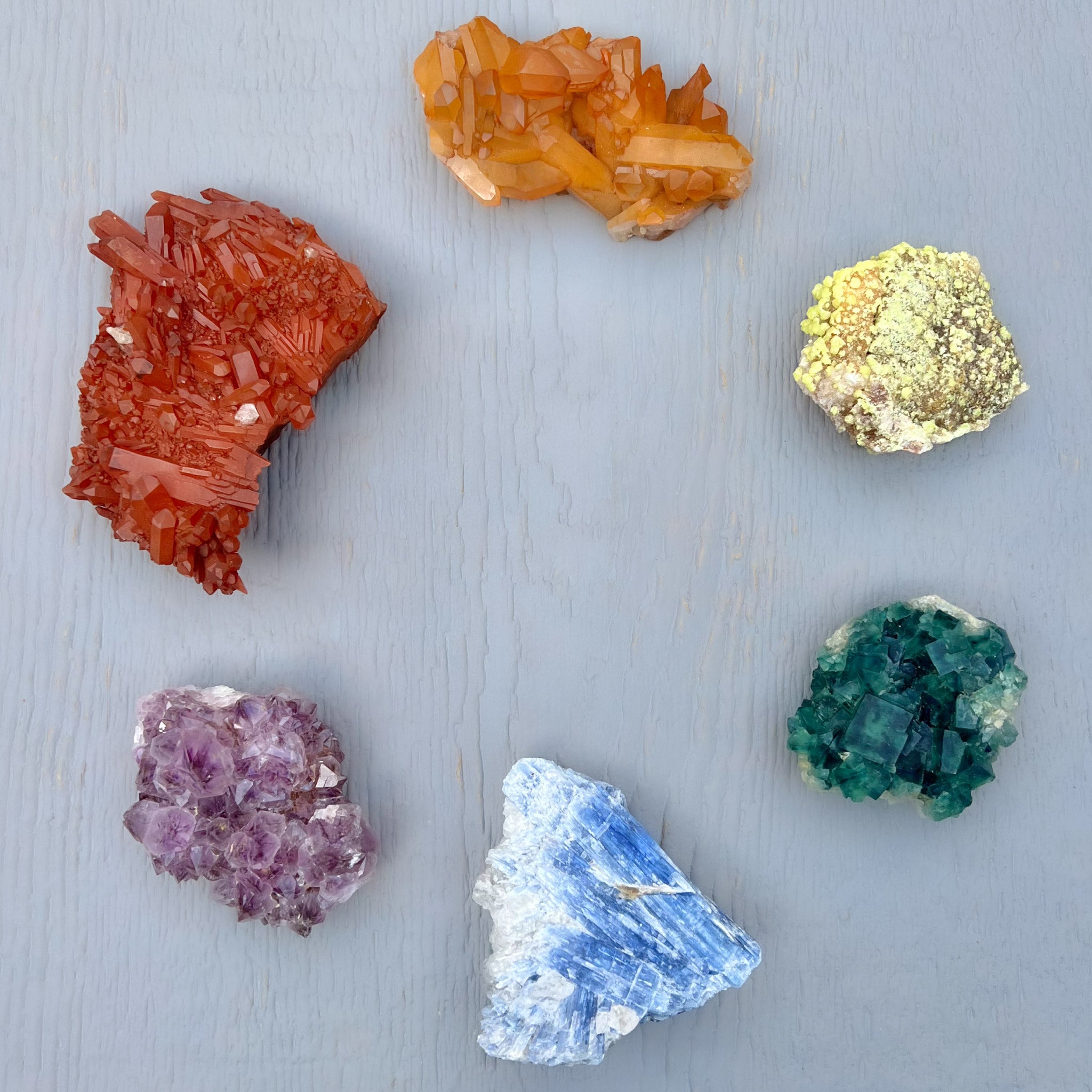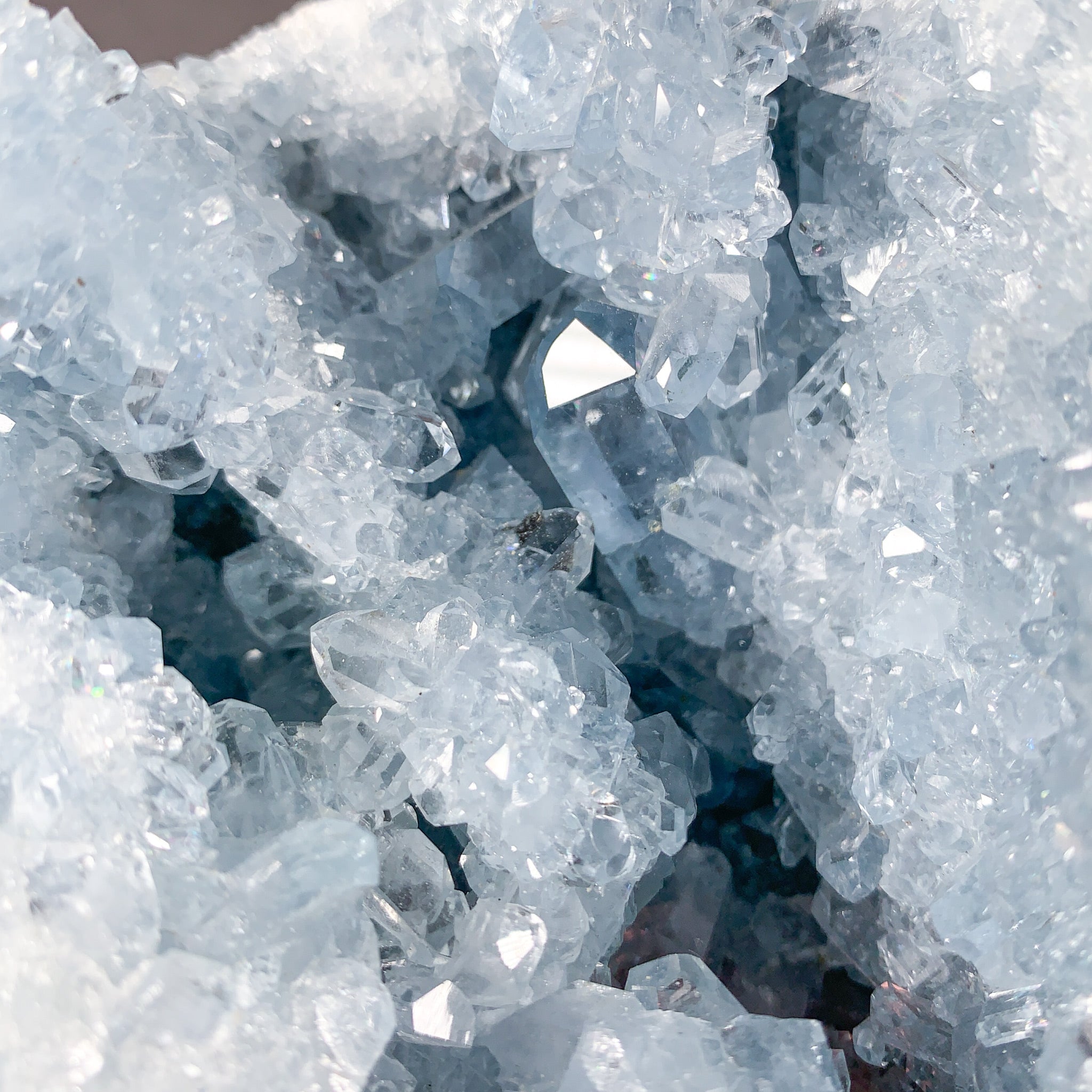Let's explore the wonderful world of Fluorescent Minerals! These magical minerals (and fossils) appear to glow when exposed to ultraviolet (UV) light. Here you'll learn about different wavelengths of light, why some rocks fluoresce and others don't, and how to get fluorescent minerals and fossils to glow!
Viewing Minerals in Regular Light vs. UV Light
When you observe a crystal or mineral specimen under regular visible light, the specimen is naturally absorbing certain wavelengths, and reflecting others. The color we observe in a mineral specimen is the wavelength which is NOT absorbed by the mineral, but the one that is reflected back to our eye.
If, however, you were to turn all the lights off in your room, or shut your curtains and use a blacklight or ultraviolet (UV) light on certain minerals, they may appear to glow!

An assortment of minerals and fossils displaying UV fluorescence
UV light is similar to regular visible light, but it has a much higher energy and shorter wavelength than visible light.
We can't see UV light, but when you observe a fluorescent mineral being exposed to UV light, it appears to glow. It is emitting light back to our eye that IS within our visible range of light.
So what is happening here?
What is Fluorescence?
When you shine a UV light on a mineral, electrons within the atomic structure of the mineral are undergoing energy transitions, in which they are absorbing energy from the UV light source and re-emitting it as visible light.
Fluorescence in minerals occurs when ultraviolet light (invisible to our naked eye), causes electron displacement within a minerals atomic structure. This allows the mineral to temporarily absorb the ultraviolet light and emit it as visible light which we can see.

Fluorescence is the temporary absorption of electromagnetic wavelengths by fluorescent molecules, which then emit that light at a lower energy level or wavelength which we can see.
If you observe a mineral displaying UV fluorescence, you are viewing the emission of light by a mineral that has temporarily absorbed the UV light. So the fluorescent molecules present in some minerals temporarily absorbs the ultraviolet light, and emits it back at a lower level that we can easily observe.
Remember, visible light has a longer wavelength or lower energy than ultraviolet light, which has a shorter, higher energy wavelength. That means we can't readily see ultraviolet light within our visible spectrum of light.
How do we Observe Fluorescence?
When we view light, we are seeing light reflected off of objects. The objects appear certain colors to our eyes based upon the wavelengths of light absorbed by that object. For example, if we observe a green Fluorite crystal, we are seeing the wavelengths that are NOT absorbed by the Fluorite, so the wavelength ultimately reflected back to our eyes is green.
With UV light, the UV radiation is actually absorbed and then re-emitted by the object. Some minerals, like Fluorite, fluoresce easily under UV light. In fact the word fluorescence actually comes from the mineral Fluorite, since Fluorite was the first documented observation of a mineral fluorescing!

But not all minerals, and not even all Fluorite specimens fluoresce....what gives?
How Do Minerals Fluoresce?
What's necessary for a mineral to fluoresce? An activator! There is typically a trace amount of "impurities" present within a mineral, which serves as an activator to allow for UV fluorescence.

A Ruby (Corundum) crystal under regular light (left) and UV fluorescence (right)
Do Fossils Fluoresce?

An Ammonite fossil displayed under regular light (left) and UV fluorescence (right)
What is Phosphorescence?

A Selenite (Gypsum) crystal cluster under regular light (top left) and displaying UV fluorescence (top center), followed by a time lapse progression of Phosphorescence
How to Make Minerals Fluoresce?
UV Lights, or UV flashlights come in a variety of different wavelengths. When we shine a UV light on our mineral specimens, we're essentially putting energy on these specimens in the form of different frequency wavelengths.
Long wave (UVA) - least amount of UV energy, 315 to 400 nanometers (nm)
Medium or Mid wave (UVB) - middle amount of UV energy, 280 to 315 nm
Short wave (UVC) - higher amount of UV energy on the spectrum, 100 to 280 nm
Some minerals will only display UV fluorescence under certain wavelengths (long or short), while others will actually show different colors under both short wave and long wave UV light depending on the wavelength.

Conclusion
Fluorescent minerals and fossils add an extra layer of awesome to your collection. They are a fun and illuminating way to observe your crystals and fossils in a new light (literally)! We hope you've enjoyed learning about fluorescence, and if you're looking to add a new piece to your collection, you can Shop Here!




